I have always been a Claussen Kosher Dill Pickle fan. Forever. I don’t like sweet pickles or bread and butter pickles, they just aren’t my thing. Claussen just tastes better, in my opinion, I don’t even like the shelf brand dill pickles. They are either too sweet or too tangy. That’s why I posted this Claussen pickle recipe several years ago.
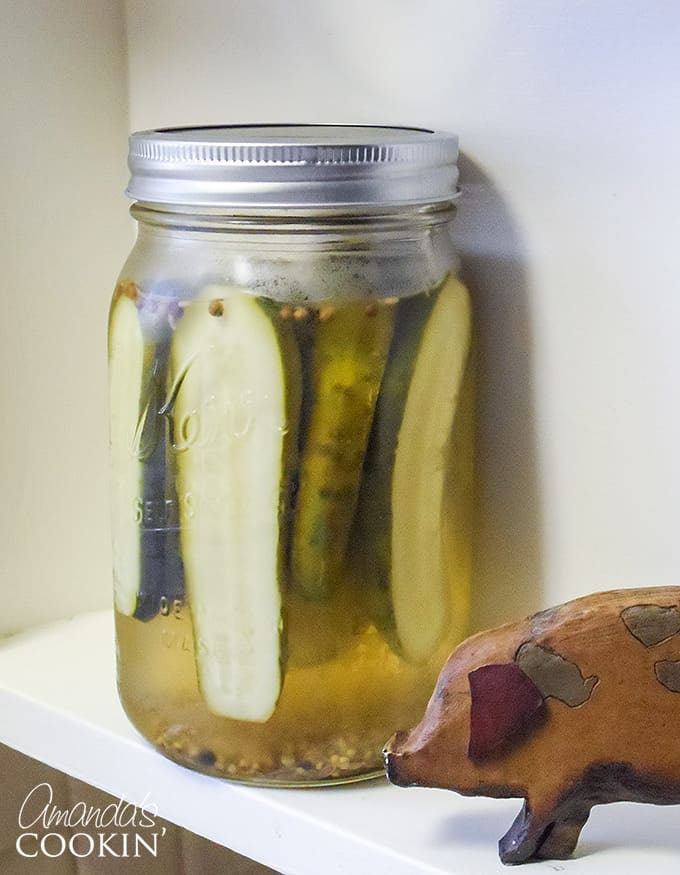
Refrigerator pickles are a lot easier to make because they don’t require using the traditional canning process. That also means they can’t be stored on a shelf in the basement or in the pantry, they must live in the refrigerator.
Recipe for Claussen Pickles at Home
Last year I made some pickles with the canning method and the recipe that I used had a very high vinegar to water ratio. So they were far too vinegary for me to eat straight from the jar, which is one of my favorite things, though they were great on burgers and in potato salad!
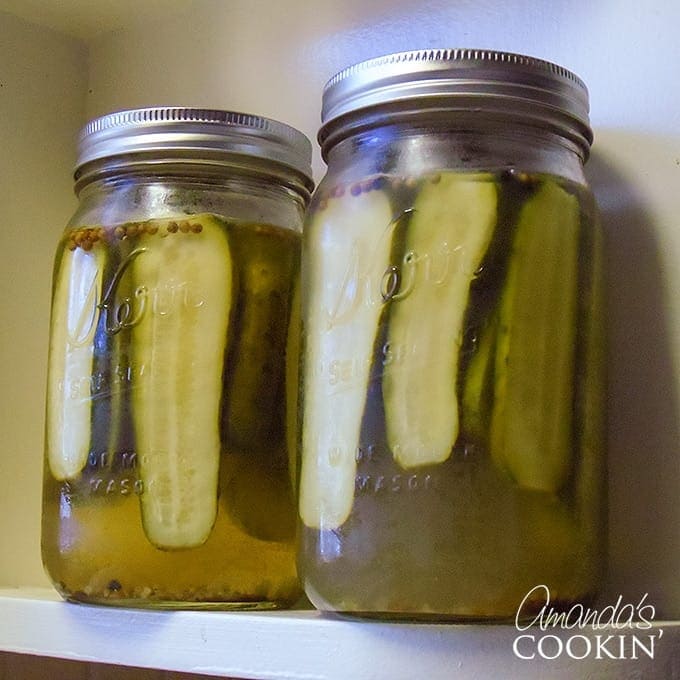
So I started my search for a Claussen copycat. I found this one but it used apple cider vinegar. I as concerned that would create a sweet pickle, which I don’t like, even though the author of that recipe is just like me. Yuk to sweet pickles!
So I looked at the actual Claussen ingredient label and it said they used distilled white vinegar. Some of the ingredients were different too, so I decided to use the recipe that I found as a jumping off point and created my own version.
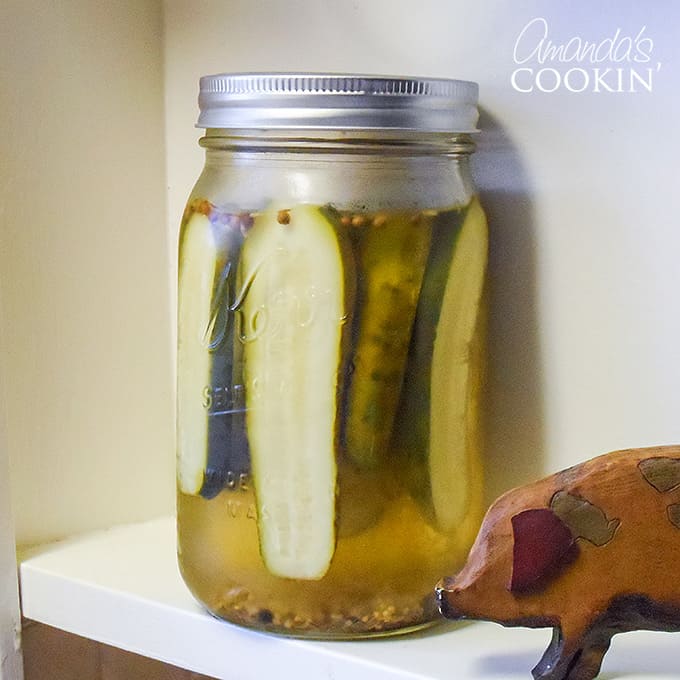
The verdict? Everyone in this house loves them! They aren’t exactly like Claussen, but pretty dang close! Close enough that they get devoured by everyone in this house.
They are actually fun for me to make. So while it would certainly be easier for me to grab a jar of Claussen from the grocery store, and I probably still will now and then, I love making my own.
My first batch was a bit cloudy, and they also had a distinctive mustard flavor. So I cut back the mustard seed in the second batch and I believe we now have a winner. :)
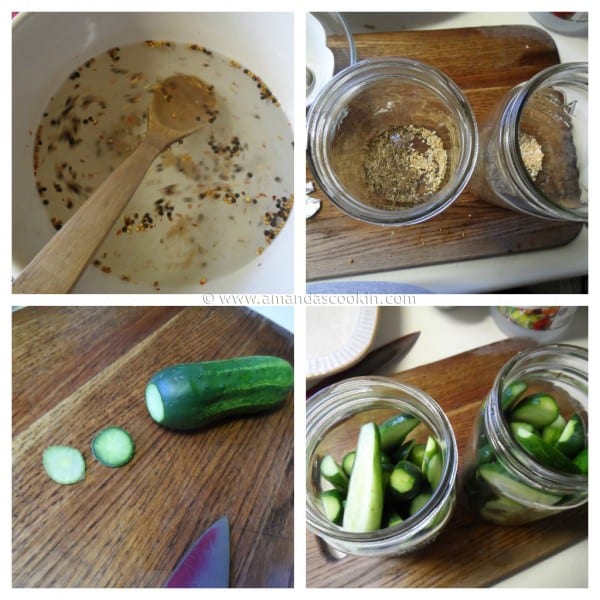
You’ll make the brine first, it’s easiest to do it in a 2-quart pitcher. You’ll see me mixing the brine in a bowl in the picture above. Don’t, it’s an extra step, just use a pitcher. Put the dill seed and dried garlic in the jars.
Now, make sure you give your pickling cucumbers a good rinse, make sure there’s no dirt. Trim the blossom end, I trim both ends, then cut in half lengthwise and distribute in your jars.
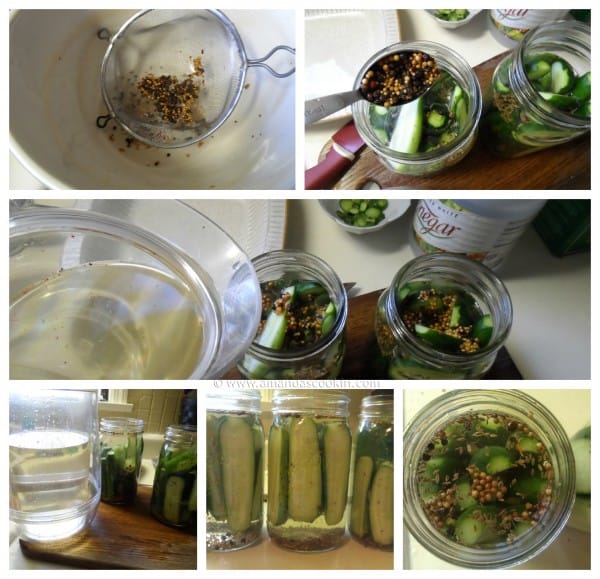
Before adding your brine, strain out the solids. Distribute the solids evenly among the two jars, then add brine. You will have leftover brine that can be discarded when you are all done.
When you perch the kid on your jars, you want air to be able to get in and gases to be able to escape.
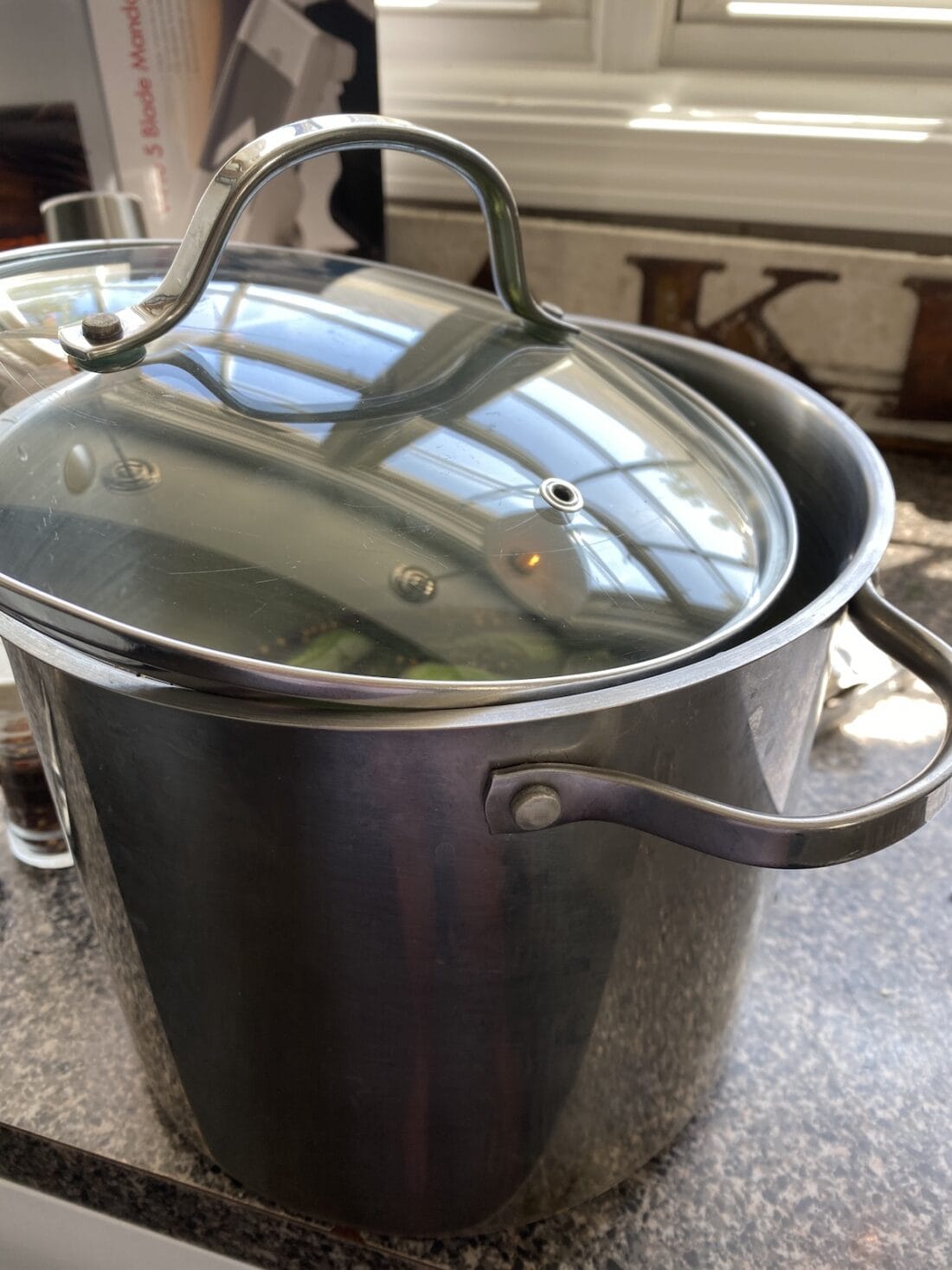
I actually put my pickles in one big pot now and then move them to a large covered glass container in the fridge instead of using jars now. Someone in the comments asked for a picture of perching the lid, you can see that above.
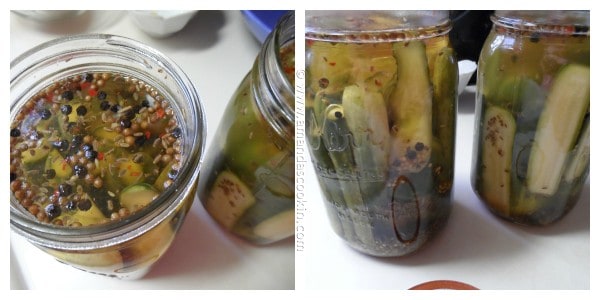
This is what they will look like after a day or so. They usually take 2-4 days. My first batch took the full four days while my second batch was ready in two and a half days. I think the difference was that I actually used three jars and they weren’t packed as tightly.
Enjoy – crunch!
Troubleshooting your pickles
Scum or film on top – During your first few days, fermentation takes place. You will probably see bubbles rising to the surface and may see some “scum” forming on the surface. Skim this off and discard. This is a completely normal step in the fermentation process.
White sediment at the bottom of the jar – According to Colorado State University, “A white sediment at the bottom of the jar may be caused by anti-caking agents in the salt or by the fermenting bacteria. Neither cause is harmful.”
According to Colorado State University “…factors that lead to spoilage include failure to remove blossom ends, failure to thoroughly wash products to be pickled, not removing the scum that accumulates on curing brines, using a weak brine or vinegar solution, not keeping the pickles covered with brine throughout the curing process, using deteriorated ingredients such as moldy garlic or decayed spices, or storing the pickles at too warm a temperature.”
You can download the complete PDF document from The Colorado State University here.
Important Tips to Note
The Blossom End
The blossom end of the cucumber (the end opposite from the stem) contains an enzyme that can make your pickles turn mushy. Always cut it off, I cut off both ends for good measure and to keep them uniform.
Vinegar
Use vinegar that has at least 5% acidity. Don’t reduce the vinegar in this recipe.
Salt
Only use pickling salt or coarse (NOT flaky) Kosher salt, though I always use pickling salt. Table salt contains an anti-caking agent that causes the brine to get cloudy. If you use table salt, it’s still safe, but you will have a cloudy jar of pickles with white sediment at the bottom.
Cucumber Types
Use cucumbers that are of the knobby variety, grown specifically for pickling. Check seed catalogs to find the different varieties. Cucumbers with a wax coating are not recommended as the brine will not be able to penetrate them. When selecting cucumbers, be sure that they are firm and not soft.
Wash Your Hands!
It’s tempting to reach in and turn your cucumbers, but please make sure you wash your hands first. Introducing any foreign oil or material from your skin could cause problems with your brine.
When your pickles are all gone, do you pour the pickle juice down the drain? Instead, try these ideas for reusing pickle juice! Looking for a unique recipe to try with your freshly make pickles? Here’s a Grilled Tomato Relish that’s great on burgers and dogs!
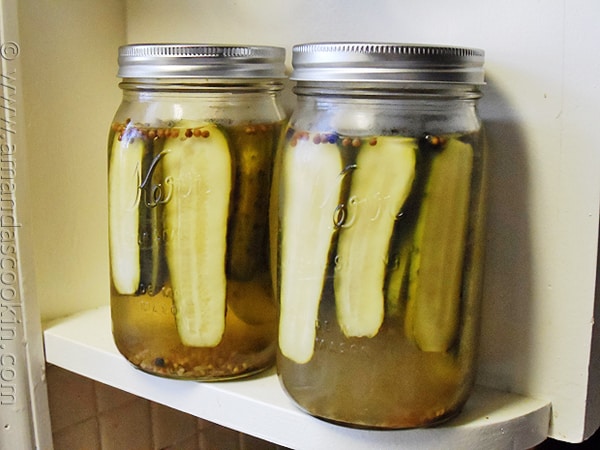
This Claussen pickle recipe was originally published here on September 18, 2012
More Related Recipes
- Cucumber Salad
- Sweet Corn and Chickpea Salad
- Grilled Corn and Zucchini Salad
- Pickled Beets
- Pickled Onions
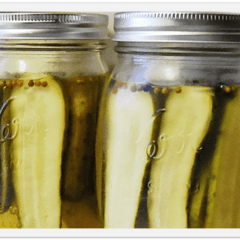
Homemade Claussen Pickles Copycat
IMPORTANT – There are often Frequently Asked Questions within the blog post that you may find helpful. Simply scroll back up to read them!
Print It Rate ItIngredients
- 20-25 small to medium pickling cucumbers
- 2 quarts cold water
- ½ cup white vinegar
- ⅓ cup canning/pickling salt or coarse Kosher salt
- 1 teaspoon coriander seed
- ½ teaspoon mustard seed
- ¼ teaspoon red pepper flakes
- 1 tablespoon black peppercorns
- 1 tablespoon dill seed
- ¼ teaspoon dried garlic
- Fine mesh colander
- 4- cup measuring cup
Instructions
- To make the brine, combine water and vinegar in a large pitcher. Add salt, coriander seed, mustard seed, red pepper flakes and black peppercorns. Stir until salt is dissolved. Set aside.
- Wash cucumbers in water and trim 1/8-inch off of the blossom end of each one. Slice each cucumber in half lengthwise.
- Divide the dill seed and dried garlic evenly between two clean quart sized jars. Fill jars with cucumber halves, fitting as many in as you can, they may be snug!
- Stir brine again to mix ingredients. Place a fine mesh colander over a large bowl or measuring cup. Pour brine through the colander, catching the brine solids in the colander. DO NOT discard!
- NOTE: You will not be able to fit all the water in this measuring cup or in the two jars. The goal here is to save the brine solids and use them, you will be discarding the left over vinegar and water mixture when finished.
- Once all the solids have been removed from the brine, distribute them evenly among the jars. Using the brine liquid in the measuring cup, pour into the jars until all the cucumbers are covered.
- Your brine level should cover your cucumbers and reach the bottom of the jar neck where the twisting begins. The cucumbers will also release some liquid as they brine, so don’t overfill the jar. Discard any remaining brine liquid.
- Cover lightly with a lid perched on top but DO NOT close and seal. Leave on the counter (out of direct sunlight) for 1 day, then move to the refrigerator for 2-3 more days, or until the cucumbers taste like pickles throughout.
- Secure lids on jars and refrigerate for up to six months.
Nutrition
Amanda Davis
Latest posts by Amanda Davis (see all)
- Cauliflower Pizza Crust - January 13, 2025
- Keto Peanut Butter Cookies - January 9, 2025
- Cloud Bread - January 6, 2025
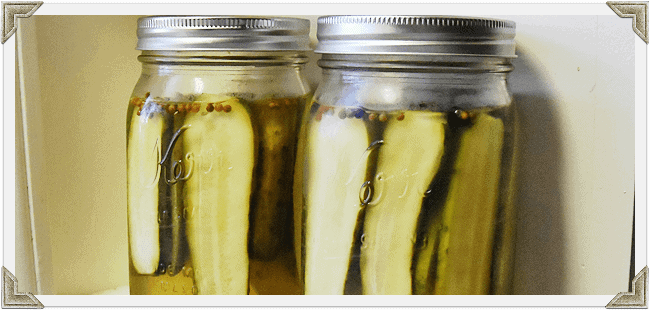
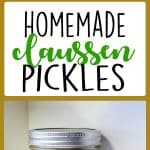
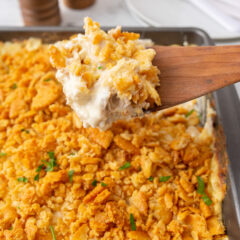
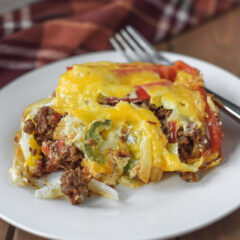
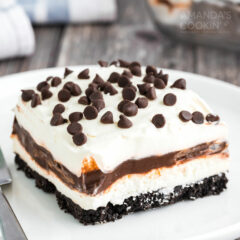
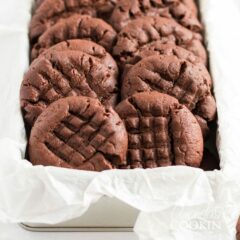





Laurie Barrett says
Yellow or black mustard seeds? Or both?
Amanda Formaro says
I’ve only ever used yellow.
Miss Heather says
three times a charm
took me 3 times to finally put in fridge just before day 2
mine went from good to cloudy so quick in the past
decided to just put in fridge a little before the cloud came
very yummy and perfect recipie so far and ive tried a few this year
Jenn Renstrom says
My pickles molded on the counter. Is 4 days the maximum amount of time that it can stay on the counter without being refrigerated? I got a little busy and Open them up on day 6 and they were very full of mold along the top. The pickles were mushy to the bottom of the jar Z well. Any thoughts?
Amanda Formaro says
Yes they really should go in the fridge on the 4th day if possible. Some people find that 2 days is enough. I’m sorry that happened!
Dawn says
Could it be made with raw garlic cloves instead of dried garlic?
Amanda Formaro says
Yes
Victoria says
Is it normal for the brine to get cloudy after a couple days? I kept them on the counter for 4 days. I didn’t really get the white slime as one poster did. I shook jars once a day just to redistribute brine.
They are in refrigerator as of today but I am concerned about the cloudy looking brine.
Amanda Formaro says
Yes it’s normal, did you use dried garlic? It can have anti-caking agents, which cause the cloudiness.
Kim Girden says
You said you cut the amount of mustard in the recipe? How much do you use?
Thanks! Looking forward to making these!!!
Amanda Formaro says
HI Kim! the full recipe with all measurements is at the end of the post, including the mustard seed :)
Shaun says
Has anyone tried actually canned this? I was thinking of just bumping the vinegar, adding .5tsp of each spice in the jar directly with a few cloves of garlic. Is that too much seasoning?
Amy says
Mine turned out super salty!!!! I used Kosher Coarse. I wonder if that had anything to do with it?
Flavor was good. I’ll make again and try to reduce the salt unless I’m doing something else wrong.
Amanda Formaro says
Hmm, I’m not sure, you didn’t use heaping measurements did you? Kosher coarse should be fine.
Rebecca says
I’ve never made pickles before and these turned out fabulous. My daughter loves Claussen pickles and these taste just like them. I let mine sit for about four days and it was just the right amount of time. I used distilled water, white vinegar, and kosher salt. It worked very well.
Amanda Formaro says
Awesome, thanks so much for sharing your experience!
Lori says
Can the brine be safely reduced? I have about 8 cucumbers to try the recipe with.
Amanda Formaro says
I think that should be fine!
Annette H Embler says
I have never seen a recipe where you do not boil the brine. Are there any cons of not boiling? I used this recipe two days ago and so far so good.
Thank you,
Annette
Marcy Powers says
How do you determine the pickles are ready to
Be refrigerated. Does the fermenting process stop? If so how can you tell for sure.
Thanks,
Marcy
Sue says
I am extraordinarily pleased with the result of this recipe. I have not been able to find any type of Claussen pickles since the pandemic.
This recipe was really easy and the results were great!
I did use fresh garlic instead of dried garlic. And when I made a second batch after my initial small trial run, I just used one large jar and added the spices directly to the jar.
Thanks for the outstanding recipe.
Amanda Formaro says
That’s wonderful Sue, thank you so much for sharing your results!
Lori says
What were the proportions of your small batch?
Candace Harris says
Hi! I was wanting to know if you can CAN these pickles? I have a ton of cucumbers so I need to be able to make in big batches that will last a longer period of time than refrigerator pickles.
Amanda Formaro says
Hi Candace. I have not tried it. I am sure you probably can, but I can’t offer any advice on it. Sorry!
Jas says
Why does your recipe say to leave these on the counter top for 2-4 days? EVERY other recipe I have read for refrigerator pickles instructs to put pickles in the refrigerator right away and to not leave them out. After I made these pickles I followed your instructions and left them out at room temperature. The jars have had slime and white fuzz is growing on the top of the brine and on the tops of several pickles. The fuzz is very difficult to remove. The jar with the most fuzz now has cloudy brine, and the pickles are limp and slimey. Wouldn’t it be better and safer to do what all the other recipes state and refrigerate right away??? I feel worried these are not safe to eat.
Amanda Formaro says
Hi Jas. Did you read the troubleshooting section of the blog post? It answers your questions.
Saul says
Are scum and fuzz considered the same thing, mine looked like white mold.
Amanda Formaro says
Yes, it’s part of the fermentation process.
Marilyn says
I plan on making these and after fermenting, freezing the excess after keeping a jar or two in the ‘fridge. I’ve read that freeing pickles will maintain most of their crispness if used within a month or two. I am a dill pickle addict, so that won’t be a problem, they’ll go quickly! I am dreaming about fetching a container when the snow is flying, defrosting them and snacking on them on a cold winter day!
Amanda Formaro says
Oh I’ve never heard that before!
Sue says
I made my recurring mistake of not reading all the directions, and I put the pickles in the refrigerator right away (overnight).
Can I take the back out and set them on the counter for a few days, or do I need to start over?
Thanks
Amanda Formaro says
It should be fine to remove them from the fridge and put them back at room temp. :) The reason for leaving them on the counter, or basically at room temperature, is to allow the fermentation process to happen. The refrigerator will slow it to a crawl. So you should be ok!
Heather Dick says
Dried garlic = minced garlic?
Mustard seed = whole mustard?
Hoping to try this!
Amanda Formaro says
Mustard seeds are not the same as whole mustard. Whole mustard is the condiment that is already prepared and has mustard seeds in it. Here’s what mustard seed will look like in the grocery store https://amzn.to/3geoIZs
And here is what dried garlic looks like :) https://amzn.to/3flh0M1
HTH!
Tera says
Amazing recipe! Better then Clausen and I didn’t think that was possible! Super crunchy. Worked out great with any variety from my garden. I just wrap my cucumbers in plastic wrap and keep them chilled until use. I’d give it ten stars if I could!
Amanda Formaro says
What a fantastic testament, thank you so much!
Dennis says says
Hi, I saw a pickling spice by McCormick I not sure about using it for it has cinnamon, bay leaves, ginger, clove, cardamom mace, and sulfiting agent, mustard seed, coriander seed, red pepper, black pepper, allspice. The “other” added ingredients could be an overload. Thank You
Amanda Formaro says
Correct, pickling spice is not recommended, it’s a completely different flavor. In the recipe and the blog post I mention pickling SALT. But not spice :)